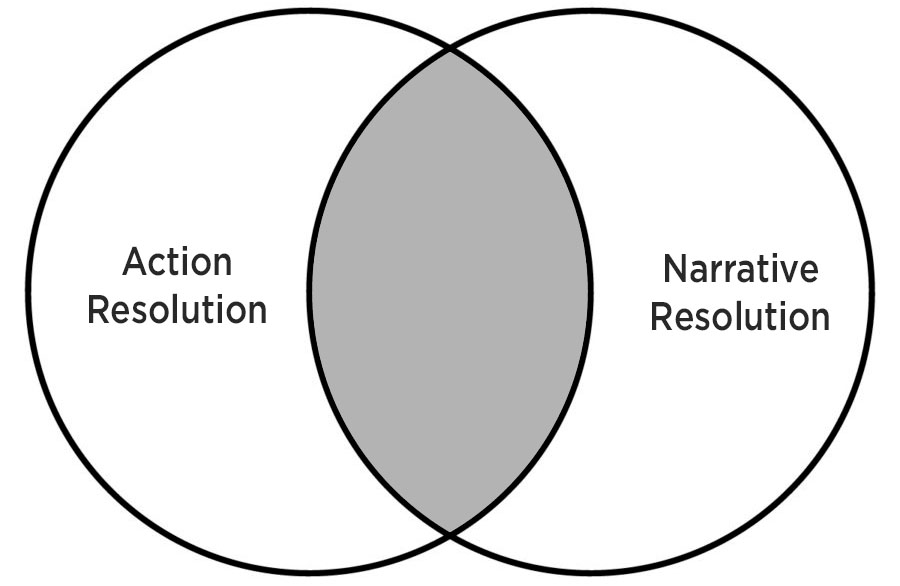 As a result of long tradition, most mechanical resolution in roleplaying games takes the form of action resolution. There is, however, an alternative paradigm that you may find useful: narrative resolution.
As a result of long tradition, most mechanical resolution in roleplaying games takes the form of action resolution. There is, however, an alternative paradigm that you may find useful: narrative resolution.
The classic example for distinguishing between the two involves the PCs trying to find hidden documents in an office with a locked safe. With action resolution, the mechanics determine whether or not they can crack the safe. With narrative resolution, the mechanics determine whether or not they find the documents. (The distinction, it should be noted, doesn’t necessarily require a different set of mechanics: Either attempt can boil down, mechanically speaking, to the exact same Lockpicking check. The difference is in how you set up the stakes for the test and in how you interpret the results of the test.)
With action resolution, the player declares “I want to do Y” with the expectation or hope that it will result in X being accomplished.
With narrative resolution, the player declares “I would like to accomplish X by doing Y”.
There are advantages and disadvantages to both approaches.
With narrative resolution, being able to say “this is how I would like to solve this problem” allows players to control their spotlight and it allows the GM to take a more general approach to prep. (The GM knows that there is incriminating evidence to be found in the club. The players decide whether they want to get it by sneaking into the office and cracking the safe, seducing the lounge singer, interrogating the club owner, or putting the place under surveillance.)
On the other hand, action resolution typically allows for a more simulationist experience of the game world (which, in its verisimilitude, can be more immersive for many). And it also allows for a more diverse array of possible outcomes (which can prevent the game from becoming predictable). (For example, the PCs succeed at opening the safe, but instead of finding the incriminating evidence of a criminal enterprise they find the mob’s blackmail photos of JFK schtupping Marilyn Monroe. Now what do they do?)
USING NARRATIVE RESOLUTION
Unsurprisingly, narrative resolution is often conducive to (and associated with) storytelling games and RPGs with a dramatist focus. But this isn’t necessarily the case: Remember that undetermined external factors are usually factored into mechanical resolution. There’s no reason that one of those undetermined external factors can’t be whether or not the documents the PCs are looking for are in the safe. The GM is simply saying, “I don’t know whether or not there’s incriminating documents in there; let’s ask the game mechanics and find out together.” (This may require a radical shift in your thinking — it’s literally a different paradigm for interpreting mechanical results — but it’s no less valid.)
Oddly, narrative resolution often combines well with failing forward. I say oddly because it seems counterintuitive that a system predicated on determining whether or not your goal succeeds would pair well with a technique predicated on assuming that your goal fails (albeit with complications). But I think it works because, first, narrative resolution is focused on the goal, and that focus makes it more natural for failing forward (which also focuses on the goal) to come into play. Narrative resolution also tends to lend itself well to larger chunks of resolution, which opens up a lot more breathing space for the sorts of interesting complications which really make failing forward worthwhile.
COMMON CONFUSIONS
When trying to grok the distinction between narrative resolution and action resolution, there are a couple common ways that I’ve seen people get confused.
First, it’s not unusual for those being introduced to the concept of narrative resolution to frame a mechanical resolution in such a way that the desired goal of the PCs is identical to the action resolution and then claim that there is in, fact, no difference between the two.
For example, you might set up a scenario where the player says, “I want to sneak over and grab the guard’s keys.” The action is to sneak over and grab the keys; the desired outcome is to sneak over and grab the keys. So, what’s the difference? Well, in this case, there is none. The two techniques resemble a Venn diagram in this regard.

Second, it’s oddly not unusual for those trying to explain the concept of narrative resolution to claim that traditional combat mechanics are a form of narrative resolution mechanic. The argument is that “make that person dead” is the desired narrative outcome and, therefore, the combat mechanics provide a narrative resolution of that outcome.
This is actually just the same error from a different angle, though. “HP 0 = DEAD” isn’t a narrative resolution mechanic. It’s just telling you whether or not you’ve killed somebody (just like an attack roll tells you whether or not you’ve hit someone with your sword). By setting the narrative goal to be “kill that guy”, you once again superficially make the action resolution look like narrative resolution.
What would a narrative resolution mechanic look like? Well, it would be “HP 0 = you accomplished whatever you goal was”. Was it to escape? Was it to convince the princess that you’re a better swordsman? Was it to impress your master? Was it to kill somebody?
A FEW FINAL ACKNOWLEDGMENTS
This concept – including the classic safecracking example – was pioneered by D. Vincent Baker using the terms “task resolution” and “conflict resolution”. Those terms have become relatively popularized and many of my readers may be wondering why I’ve chosen to swap them out for the terms “action resolution” and “narrative resolution”.
Basically, having participated in several dozen discussions about this topic over the last decade or so, I have found that the terms “task resolution” and “conflict resolution” are a source of deep and consistent confusion.
First, the common definition and usage of the term “task” is frequently goal-oriented: You are assigned a task and then determine how you are going to accomplish that task. This seems to heavily contribute to the first point of confusion described above (where people can’t distinguish what the difference is supposed to be between the task-oriented and goal-oriented resolution methods).
Second, the term “conflict resolution” only makes sense within a very specific and adversarial understanding of the interaction between the GM and the players. If you look at the lump sum of Baker’s thoughts back in 2004 (when he was struggling with and exploring the implications of this relationship), it makes a lot of sense why he chose the term “conflict”. But outside of that specific context, it tends to lend itself to the second point of confusion discussed above. I’ve also seen it frequently lead people astray who then believe that “conflict resolution” only applies if an NPC is opposing the PC (either directly or indirectly).
I don’t really consider it likely that my revised terminology will have widespread adoption at this point, but that’s not my primary concern: My primary concern is to attempt to clearly communicate a useful set of concepts to those reading this essay.












Terms:
* Task vs Action — you’re right that Action is better.
* Conflict vs Narrative — you’re right that Conflict is misleading, but I don’t thing “narrative” is right either. It has lots of connations, especially in rpg circles, that are distracting here.
Actual concepts:
In your description of the difference I think you’re blurring together two separate things:
* Level of abstraction, or scale, of resolution (e.g. “sneaking up to the toilet window” vs “getting the plans for the safe”)
* Power to define facts that haven’t been established in play yet (e.g. “the safe is empty because the GM previously decided it was empty” vs “the check succeeded so the plans are indeed in the safe”)
My memory of using narrative resolution (in TSoY, BW and a version of nWoD I hacked to include it) is that I used abstraction/scale a lot (so one roll covered a lot of in-game actions) but I used a very conventional approach to the reality of game-world facts — if the GM had committed, then it stood. And my memory is that that was what the books and game communities were telling me to do.
It has been about four years since the examples I’m thinking of, so my memory may be hazy, but I think that that’s what was doing. And it still lead to a game that felt very different to how I run DW or D&D variants (with mostly action resolution).
I haven’t read your link to Baker yet, so I guess he may have a different view. But, if so, he may be the one out of step with wider practice.
How would I have handled the example with the safe? I’m not sure. One option would have been to reveal ahead of time whether the documents are in the safe or not – in those games, I gave players quite a lot of metagame information that they were expected to firewall. A real example from BW:
Me — “Ok, so you’re going to use Engineer forked with Weather-wise to assemble a sea wall that will prevent major harbour damage when the storms come. Difficulty is… 3. If you fail, the wall will seem sound, but actually it will have a flaw such that it will collapse in the first major storm and make the harbour damage even worse.”
Player rolled and got maybe one success. They knew that their sea wall was a disaster, but couldn’t act on that information.
Another, more likely, option is that I’d have said:
“You can’t have stakes that you ‘retrieve the documents from the safe’ because you don’t know if they’re there. You could have ‘Find out if the documents are in the safe’, or ‘Get the contents of the safe’. Either of those good?”
One interesting example of a game that leans way into action resolution (now that I think about it) is Disco Elysium. If you attempt to do a thing, and you roll high, then boy, do you do *that thing*, regardless of whether doing that thing represents success in a broader sense. Of course, this being a video game, what you can even try to do is limited (and it often depends on the success of previous checks).
Reading that Baker post, this passage struck me:
“That’s, if you ask me, the big problem with task resolution: whether you succeed or fail, the GM’s the one who actually resolves the conflict. The dice don’t, the rules don’t; you’re depending on the GM’s mood and your relationship and all those unreliable social things the rules are supposed to even out.”
Because, a priori, that’s what I would have said about *narrative* resolution. With action resolution, sure, it’s ultimately the GM’s decision, but what generally happens is that the GM comes to that decision by means of things like roleplaying the NPCs and establishing the situations, not just on a whim.
I think that in Baker’s example of a GM resolving a failed task-resolution check with the character succeeding anyway, that GM is making a mistake: he’s autopiloting the PC, like the GM in the Preempting Investigation post. In a sense it’s also a case of morphing reality: why are you only noticing them now, with neither a check nor any indication from you that your character wants to look at the trash next? The GM put them there two seconds ago, to avoid having consequences for failure. I think *that’s* the problem with the example, not task resolution.